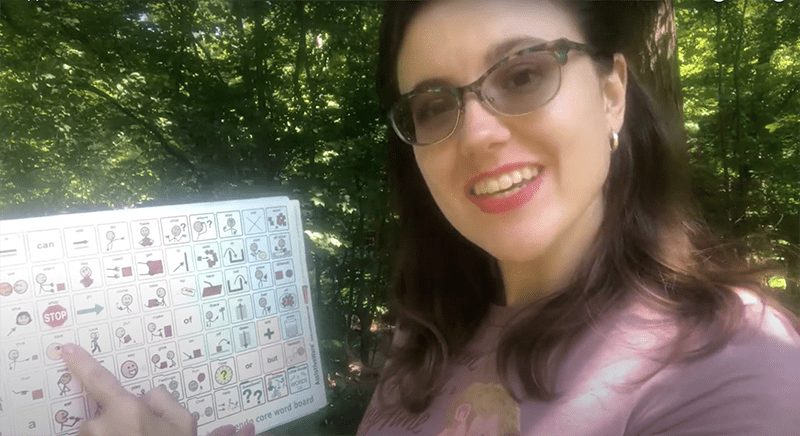By Shelley Harris, Early Literacy Librarian
Learning is a key and consistent part of my job. The highlight of my learning year is the Assistive Technology Industry Association’s annual ATIA conference. I attend the conference every winter and bring back program and accessibility ideas for the library to implement.
This year, we met virtually, yet I came back with more ideas and knowledge than ever! But before I dive into the new ideas, let me recap some of what I’ve helped implement at the library based on learning from previous years:
- I have coordinated Supported storytimes and programming for kids with disabilities for nearly a decade now, and have used what I learn at this conference to continually expand what our library offers.
- I’ve written before about how inclusion drives my work. Many of the accessibility tools the Oak Park Public Library has launched, such as scanner pens and UbiDuo communication devices, came from ATIA sessions.
- I’ve learned best practices around creating Supported cooking and music classes, which led to multiple new Supported classes for kids and tweens with disabilities.
- Hearing that 77% of adults with disabilities don’t engage with community events led to creating the accessible sensory garden at the Maze Branch, which is planted and tended by kids and teens with disabilities and is for community use.
Fresh learning from AITA 2021
Take an eye break
First, we all spend so much more time on computers now. Every 20 minutes, kids and adults should take an eye break.
Let’s do one right now. Look away from the screen at something 20 feet away, or cover your eyes for 20 seconds.
We also learned that people may find that their eyes get tired as the day goes on. It can help to make your own accessibility changes after lunchtime: increase font size or resolution, or change documents to have a blue background with white text.
More digital accessibility
Several sessions were about providing accessible digital access. We want to make sure all Oak Parkers can get the information they need from the library. This goes past the captions we already add to our videos into how we write our content and display it.
Everyone can make their documents and social media content accessible with little extra work, including image descriptions on Twitter and Instagram. Learn about font readability and your most easily read font at http://readabilitylab.xyz.
Sessions also discussed plain language, a style of writing that allows more people to quickly read and understand content. ProPublica wrote a series of articles about challenges that disabled people have had getting the supports they need, and shared it in both journalistic style and plain language style.
We’re excited for the Web Accessibility Guidelines 3.0 to be released. It is still in draft form and includes a cognitive and learning disabilities task force. It’s time for best practices in accessibility to support more people!
New activities & supports for kids through grade 8
As a Children’s Librarian, my focus is on learning new activities and supports I can use with kids up through 8th grade.
This year, that included a wonderful session showing how to hold successful coding classes for kids who identify as autistic, which could easily be broadened to support any interested child or tween who is disabled. LearnStyle in Toronto has experience leading these classes in person and virtually through the pandemic, and shared how they set kids up for success.
Learning from others, sharing with colleagues
I also learned about programs that many teachers are using. Flipgrid was initially created for d/Deaf students, interactively pairing text and video, which can be used to share content in American Sign Language. It also can support kids who learn best through watching, listening, or hands-on creating.
Thinglink allows people to tag images with written explanations, video demonstrations, and so on. The library possibilities are endless: an on-demand virtual field trip, an immersive trip into the history of different American Girl dolls, or expanding experiences with our Discovery Kits.
I also was able to share ideas with staff members and colleagues, including tween and teen lesson plans and 3D printing recipes for assistive tools, ways to partner with high school robotics teams for personalized accessibility tools, technology tools to address senior isolation, and new ways to offer virtual programming.
Disabled people are experts
One of the best parts of ATIA is that it is an international conference, and disabled people are seen as experts.
Many sessions are led and attended by disabled people, disabled people work at the companies who are involved and work the booths, and there are forums run by and for only people with disabilities.
The whole world comes together to learn, and it fills me with joy.
I look forward to working with my colleagues to explore new ways to implement what I learned from over 20 sessions this year and to learn more next winter.
Early Literacy Librarian Shelley Harris holds a Bachelor of Science in Speech and Hearing Science and a Master’s in Library and Information Science. She is the older sister of a young man with a rare genetic disorder who has used augmentative and alternative communication (AAC) for nearly 30 years. Harris has worked in western suburban Chicago schools as a para-educator for deaf and autistic children. She is available for talks and training.

